The Lost Church of Ledgewood
In the early years of our state the
most substantial buildings in a town were often the churches. As time
passed on, many of these congregations outgrew their sanctuaries and moved
to new structures, or they diminished and the sanctuaries were demolished or
used for a different purpose. The website
<www.njchurchscape.com/Morris-list.html> gives information and photos on
many of these abandoned churches but one is missing -- the original First
Baptist Church of Ledgewood, New Jersey.
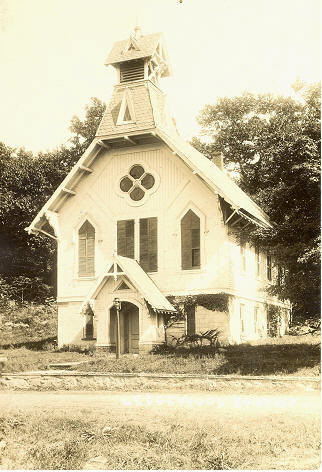
Baptists were relative latecomers to Roxbury. Starting in the 1840s there were enough Baptists in the area to conduct a Sunday School in the old Ledgewood School House. Every two weeks the pastor of the Schooley’s Mountain (now Mt. Olive) Baptist Church would preach a sermon after the Sunday School was held. By the 1870s it had grown enough that they decided to start their own church and 30 people transferred their membership from Schooley’s Mountain and organized a Baptist church in Ledgewood, which was then known as Drakesville (sometimes spelled “Drakeville”).
Churches always prefer a permanent structure to meet in, so they raised money to build a new church at the top of Main Street. By May 1874 the basement was finished and services were started there. The “troglodyte” congregation must have been patient because the church cornerstone wasn’t put into position until a year later (and can still be seen, except that it is now on the current church; photo below) and the upper structure took at least another year to finish, probably due to financial straits.
It was not a rich church. In the membership application letter they sent to the North Jersey Baptist Association they wrote, “We have not much of this world’s goods, but we have faith and mean to work.” The lack of funds put a lot of pressure on the early pastors and their ministries tended to be short-lived. The founding pastor, Rev. John G. Entrekin, only stayed two years and none of the first seven pastors stayed more than five years. There were long periods where there was no regular pastor and the pulpit was filled with whomever they could get that week.
The final cost of the original church was the grand total of $5,000. It was built of wood and had abundant gingerbread that was popular in the Victorian era. The windows seem to have been plain glass though there was a simple rosette window near the peak with geometric patterns in stained glass. The interior had a balcony across the back which was popular with the youth. There is even a story of Bob Stark’s uncle Earl, a teenager back then, who sneaked into the balcony during a special service and fell asleep; he woke at 2:00 a.m. to find the church securely locked. There are numerous photos from of outside of the structure but there is only one that appears to have been taken within the church. It shows patriotic bunting across the front of the sanctuary and 42 members who are dressed up in antiquated costumes for a play.
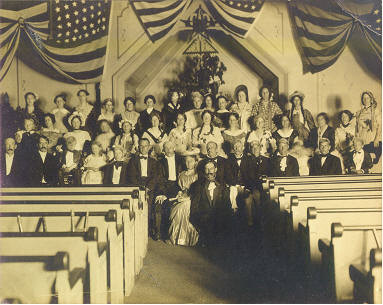
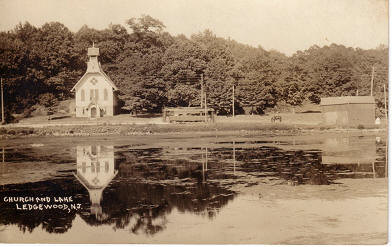
The village of Drakesville was largely undeveloped back then and most of the roads were unpaved. Across the street from the church was a large mill pond. The remains of its dam can still be seen along the brook - the small pond created by former resident Sam Mino is on the same spot but is only a token reminder of the pond that once ran from the mountain to Main Street. Numerous photos taken of “Gala Day” swimming races show the church in the background.
The next positive development was the arrival of Rev. John Earle in 1914. He was conservative in theology, as almost all the Baptist preachers here have been, but he was committed to the Northern Baptist Convention and would not let his church leave the denomination as the Netcong church (now Grace) and Mt. Olive churches did. Rev. Earle was well-known for being stern and strict, against makeup, pants on women, modern music or frivolity of any kind. He wore a suit and tie even in his own home. If a teenage boy came to church without a coat and tie, he sent him home. Many young people attended the church nonetheless and the annual Children’s Day service, held the second Sunday in June, dates back to our days in the old wooden chapel.
Rev. John Earle around 1915
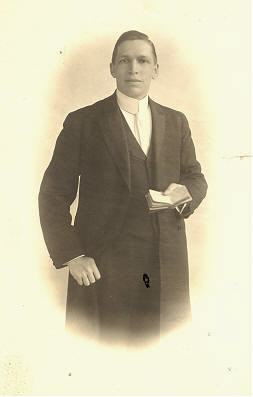
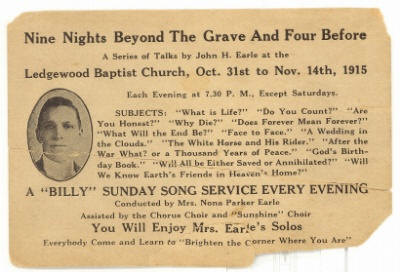
Revival publicity card - two whole weeks of
preaching
(today revivals usually last three days)
George Bellow’s drawing of Billy Sunday in action, 1915
Earle may have been strict but he was also effective as an evangelist. One of the calling cards for a revival he conducted - two weeks long! - mentions a “’Billy Sunday’ song service.” Billy Sunday was a converted baseball player who followed in the steps of Dwight Moody and laid the foundation for Billy Graham; these three established modern revivalism. We do not know how emotional Rev. Earle’s sermons were in this period (later members thought he was rather long-winded and dry) but he added 124 members in just a few years. They soon outgrew the little wooden church and there was talk of adding an addition to it. Others had bigger thoughts and set their eyes on a plot of land farther down Main Street that was owned by Mr. King. He was a good Baptist and donated the land to the church.
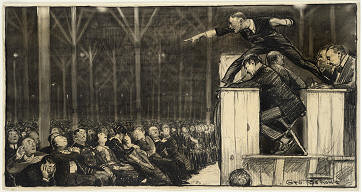
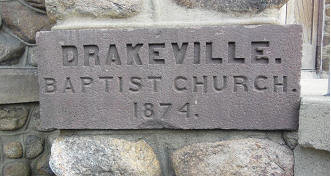
In 1916 construction began on the current Ledgewood Baptist Church. The old cornerstone was brought down and placed opposite the new cornerstone on the church tower. The new church cost three times as much ($15,000) but was paid off within six years. The back extension of the church was not completed until the 1930s so the old church continued to be used for Sunday School classes. Local fraternal organizations were also allowed to use it. Some members recalled that the pews were removed and the young men played basketball in the old sanctuary. A photo from this period shows weeds growing up the outer wall (see first photo).
Mr. PeQueen eventually purchased the
old church and converted it into a private home. In the 1980s it was made
into commercial offices and today houses “The Environmental Group.” The
gingerbread is all gone and the tall windows have been reduced to normal
size but the entryway on Main Street still recalls its more glorious
genesis.
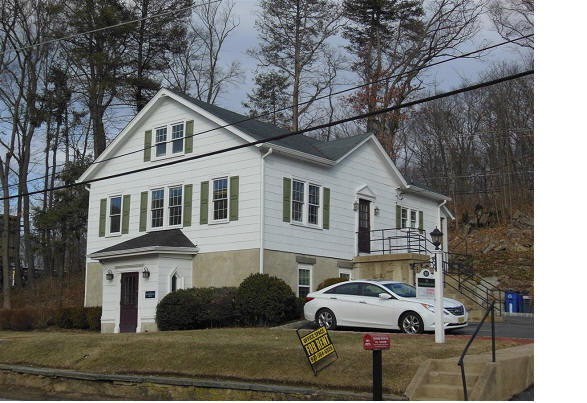
The “Lost Church” as it
appears today at the top of Ledgewood’s Main Street
________
Rev. W. David Holwick
Pastor, Ledgewood Baptist Church
January 22, 2015